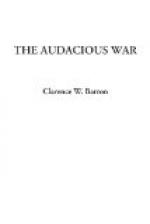Counting Montenegro and Servia as two nations, there are now seven countries at war against Germany, Austria, and Turkey, and two more, possibly three, may join in within a few weeks. If Greece enters the battle-line, it will be ten nations against three. When Roumania and Italy join the Allies, as is now being diplomatically arranged, Germany will be completely surrounded, with Switzerland, Holland, and Denmark in a measure locked in and powerless to give aid or assistance to the Germans. Indeed, these three smaller countries and Scandinavia are practically locked in now, with the North Sea placed in the war zone, and Italy as well as Denmark and Holland shutting out all contraband goods for reexport to Germany and Austria.
Thus we have the spectacle of two nations of more than 115,000,000 people actually surrounded and besieged. Jointly these two nations in occupation of their entire territory could feed themselves from their own soil. They cannot be starved out, as in a besieged city, for lack of bread, meat, or drink. But the siege at the present time is not against the people of Germany and Austria: it is against the war-machine of Germany. This war-machine can be starved out when cut off from gold, copper, rubber, and oils. If these cannot be cut off, then her men must be cut down.
Germany has raised by war-loan $1,100,000,000. She has spent this and $500,000,000 more besides. The financial strain is shown in her paper and exchanges at discounts outside her own border. Within her own realm she is piling up a gold reserve in her great bank, to sustain her expanded paper issues and her strained credit; but how is she securing the gold?
Calling a mark a shilling, or 25 cents, let us speak for a moment of Germany’s finances in marks. After the war of 1870 she planted 125,000,000 marks in gold from the French indemnity in her war-tower at Spandau. In June, 1913, the Reichstag voted to double this to 250,000,000 marks in gold, the addition to be known also as the Spandau tower reserve, but to be placed in the Reichsbank and not counted in the bank reserves. There was also to be coined 125,000,000 marks in silver.
The whole was simply a stirrup-cup to enable Germany quickly to bound into the war-saddle with purchase of horses, food, and the light or perishable munitions of war which must be had at the outset and at a time when war panic first seizes the currency and supplies of a community.
The basis of German finance was 1,200,000,000 marks in specie, mostly gold, in the vaults of the Reichsbank at Berlin—the central bank of issue and bankers’ deposits—with its 485 branches.
Before the war this metal reserve had been brought up to 1,400,000,000 marks. At the outbreak of the war, of course, the Spandau tower reserve in specie must have gone into the bank, and every metal reserve that the government could lay its hands upon likewise went into the bank. Germany then boasted a gold reserve approaching 2,000,000,000 marks. In this month of February the bank gold reserve was put well above 2,000,000,000.




